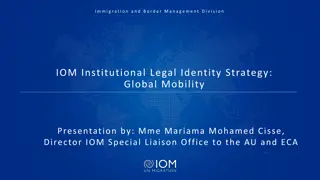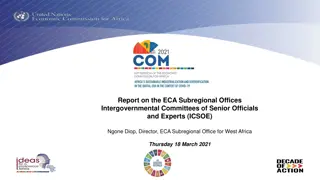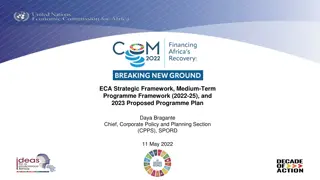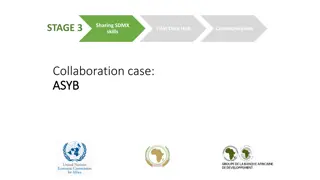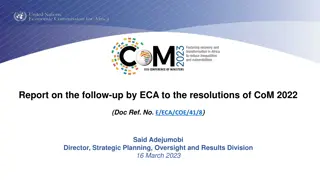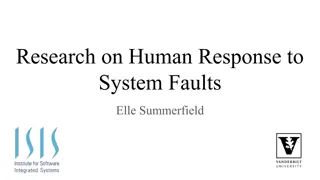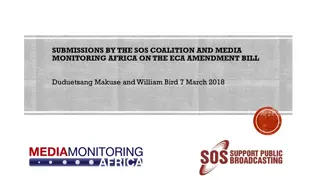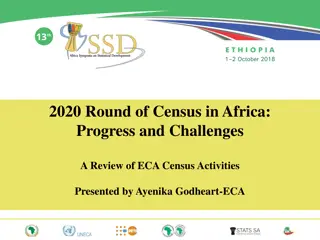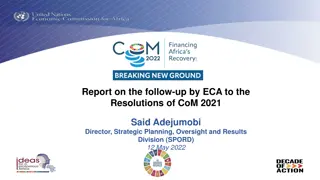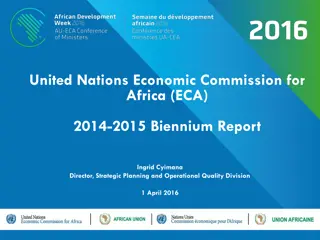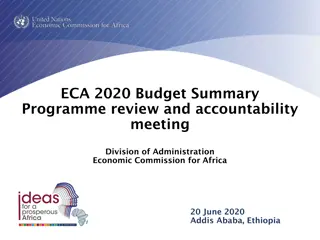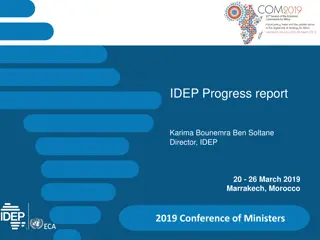
Data Disaggregation for SDG Indicators: Insights from a Sub-Regional Workshop
Delve into the results of a self-assessment survey on practices and challenges relating to data disaggregation of SDG indicators. This overview covers statistical principles, regulatory frameworks, and specific insights on data disaggregation and the SDGs from a workshop in Lilongwe, Malawi.
Download Presentation

Please find below an Image/Link to download the presentation.
The content on the website is provided AS IS for your information and personal use only. It may not be sold, licensed, or shared on other websites without obtaining consent from the author. If you encounter any issues during the download, it is possible that the publisher has removed the file from their server.
You are allowed to download the files provided on this website for personal or commercial use, subject to the condition that they are used lawfully. All files are the property of their respective owners.
The content on the website is provided AS IS for your information and personal use only. It may not be sold, licensed, or shared on other websites without obtaining consent from the author.
E N D
Presentation Transcript
CEA Overview of the result of self-assessment survey on practices and challenges on data disaggregation of SDG indicators Sub-regional workshop on Data disaggregation L andre Ngogang African Centre for Statistics Lilongwe, Malawi, 27 September 1 2017
Outline 1. Statistical principle and regulatory framework 2. Data disaggregation and the SDGs 3. Data disaggregation General information
Statistical principle and regulatory framework
Statistical law A national statistical law regulates the development, production and dissemination of official statistics in the country in all surveyed countries. The National Statistical Law is obsolete, including in its existence, in two countries Enter in force 1914 1963 1964 1967 1967 1967 1969 1972 1985 1998 1999 2002 2002 2005 2011 Revis ion 2007 2005 2009 2013 2016 2017 2015 7 countries have revised their statistical law The national statistical law regulate statistical activities conducted by all producers of official statistics in 9 countries, only NSO s activities in 3 countries
Statistical law Specific regulatory frameworks governing statistical activities conducted by other producers of official statistics than the NSO always make an explicit reference to the national statistical law in only 5countries. Often in 5, Seldom in 3 and never in 3 The national statistical law of 12 countries () makes explicit reference to the UN Fundamental Principles of Official statistics The national statistical law of 10 countries () makes explicit reference to the African Charter on Statistics and/or other regional/national statistics code
Statistical law In 7 countries, the national statistical law makes specific reference to the disaggregation on data by specific groups or certain characteristics in only one country , legal frameworks or laws explicitly prohibit disaggregation by specific groups or certain characteristics: Race. Some statistics law are under revision
Data disaggregation and the SDGs Age, sex, disability status, ethnicity, income, migratory status, Geographic area
Data disaggregation by age and sex In almost all surveyed countries the NSS there are currently official statistics disaggregated by age and sex. The dissemination of such statistics is effective in practically all these countries. This type of disaggregation is a legal requirement only in 4 countries There is no legal restriction preventing certain statistics to be disaggregated by age (in one country only)
Data disaggregation by age and by sex Disaggregation by age and sex is generally done with survey and censuses data. It is done also for administrative record as education statistics, health statistics Disaggregation by sex and age is a priority area for disaggregation
Data disaggregation by disability status The National Statistical System currently disaggregates official statistics produced by disability status (13 countries) This is legally required in 4 countries There is no restriction preventing this disaggregation Main sources used are household surveys (particularly disability surveys) and censuses
Data disaggregation by disability status The countries planned to disaggregate additional data (13 countries) by adding disability module in existing surveys and census The main challenges include: Appropriate sampling technics Mastery of concepts since some are new
Data disaggregation by Race/Ethicity Production and dissemination of official statistics disaggregated by race/ethnicity is mitigated: 10 countries produced and 9 do not; 7disseminate and 7 do not Although there is no legal restriction preventing certain statistics from being disaggregated by race/ethnicity, the NSS is not giving priority to this type of disaggregation Information allowing such disaggregation are not even collected in some countries (long standing accepted practice)
Data disaggregation by Income There are Official Statistics produced and disseminated by the NSS disaggregated by income in 12 countries. There are legal requirements for certain statistics to be disaggregated by income in two countries There in no legal restriction preventing certain statistics from being disaggregated by income Data source generally used is income/expenditure survey
Data disaggregation by Income This type of disaggregation is seen as a priority by the countries The main challenges in producing such data include: Surveys without income module where a proxy is needed reluctance to disclose income by the respondents Accuracy of income collected
Data disaggregation by Migratory status Disaggregation of official statistics by migratory status is not a common practice in NSS. Official Statistics produced by the NSS disaggregated by migratory status exist in 9 countries and is and disseminated in 8 Legal requirements for certain statistics to be disaggregated by income exist in two countries Only half countries see this type of disaggregation as a priority. Consequently, only 4 countries have future plan to disaggregate additional data by migratory status Data sources used are Censuses and Demographic Surveys
Data disaggregation by Geographic area There are official statistics produced and disseminated by the NSS currently disaggregated by geographic area in almost all the countries surveyed legal requirement compels NSS to disaggregate certain statistics by geographic area in 5 countries Main source of data used are censuses, MICS, DHS, Living Standard survey
Data disaggregation by Geographic area This type of disaggregation is a priority for all the countries Challenges: geographic obtained at higher cost for the survey Sample size limitations Appropriate skills
Other disaggregation categories The NSS seem focusing on data disaggregation by standard categories. In only 8 (7 resp.) countries there are official statistics produced (disseminated resp.) currently disaggregated by other categories Not in general a legal requirement Not a priority area for disaggregation (6 Vs 10)
Data disaggregation General information
Data disaggregation General information Efforts to ensure consistency across the disaggregated data cross checking techniques Trend analysis, comparison with external data Data validation during workshop with specialist Demand from users for disaggregated data and information is increasing in all the countries The countries plan to integrate data from other sources into the NSS for the follow up and review of the 2030 Agenda and the SDGs and to increase the availability of disaggregated data (MoU, capacity building, partnership, training )
NSOs role in reporting and follow-up and review of the 2063 Agenda and SDGs Development of Agenda 2063 and the SDGs indicator framework Monitoring and evaluation of the SDGs Collect data and report on indicators that address 2030 Agenda for policy makers Preparing of the baseline report data gathering to determine the gaps and other sources to fill the gaps within the national statistical system and civil society as well as other innovative ways
CEA Thank you! UNECA.ORG


